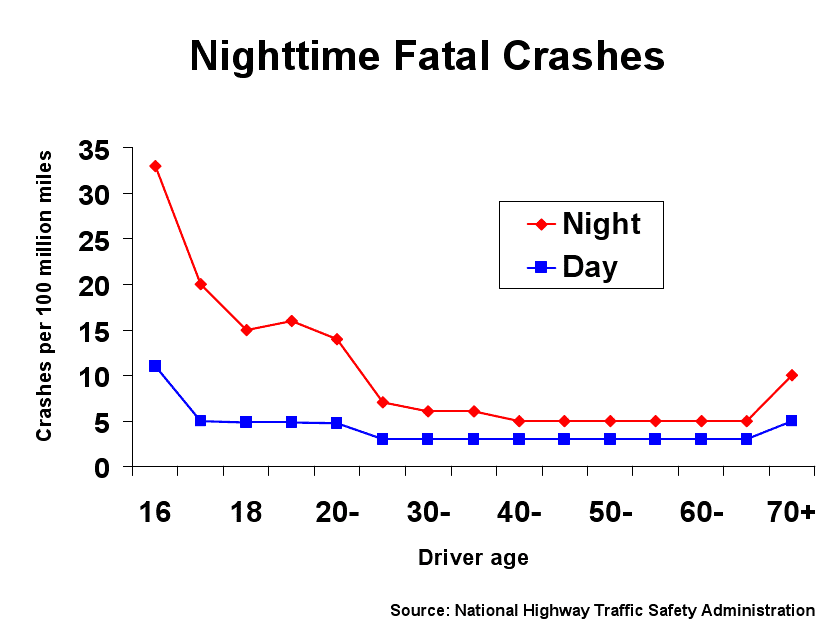Navigating the roads at night poses increased dangers for teenagers. A lack of awareness regarding night driving safety contributes significantly to fatal accidents. Take the initiative to educate yourself about the essentials of staying safe while driving at night.
To become a well-rounded driver, especially if you’re just starting out, it’s essential to get behind the wheel in all kinds of situations – including driving in the dark. Just like you’d take extra care in bad weather, there are some simple tips to keep in mind for night driving, no matter how much experience you have. Today, we’ll provide valuable advice for navigating the roads safely between dusk and dawn.

Cruising in the Dark – A Teen’s Guide to Driving at Night
For novice drivers and experienced motorists alike, here are three main measures to take to drive safely at night:
- Slow down – When it comes to night driving, giving yourself that extra time can make a world of difference—so why not slow down? Driving at a more leisurely pace enhances safety for several reasons. First and foremost, reduced speed allows for better reaction time, giving drivers the chance to respond promptly to unexpected obstacles or changes in road conditions. Additionally, driving slower lessens the impact of limited visibility during the night, allowing you to spot potential hazards earlier and avoid them with ease. So, the next time you find yourself on the road after dark, remember that taking it slow isn’t just a cautious approach; it’s a smart strategy for ensuring a safer journey.
- Learn how to use high beams properly – Mastering the art of using high beams is crucial for night driving. Activating them provides a clearer view of the road, but a golden rule applies: never use high beams when close to another vehicle. Switch them off within 500 feet of an oncoming vehicle or when driving behind someone.
- Prioritize vehicle maintenance – Prioritizing vehicle maintenance is another key to safe driving day or night. Regularly check and test your low and high beams, turn signals, brake lights, and daytime running lights. This ensures you remain visible to others and maintains your awareness on the road. If you detect a burnt-out light, address it promptly to uphold optimal vehicle visibility and safety.
Preparing Your Car for Nighttime Driving
Driving at night poses its own set of challenges, and ensuring your vehicle is in optimal condition is crucial for a safe journey. Here’s a checklist to go through before hitting the road in the dark.
Check Your Lights
One of the most critical aspects of nighttime driving is the functionality of your vehicle’s lights. Ensure that all headlights, taillights, brake lights, and turn signals are working properly. Dim or faulty lights can significantly reduce visibility, increasing the risk of accidents. Regularly clean the headlights to remove dirt and grime, as this can limit the projection and effectiveness of your lights.
Keep Your Car Clean
A clean car isn’t just for aesthetics; it’s also a safety consideration. Dirt and debris on your vehicle can limit light projection and visibility. Before driving at night, take a few minutes to give your car a thorough wash. Pay special attention to windows, mirrors, and lights to ensure maximum clarity.
Check Your Dashboard and Driver Display Lights
Your car’s dashboard and driver display are not just for aesthetics—they provide essential information about your vehicle’s health. Before heading out at night, check for any warning lights on the dashboard. Addressing potential issues beforehand can prevent breakdowns and ensure a smoother nighttime drive.
Night Driving: Prepare Yourself to Drive in the Dark
Your vehicle is ready, but what about you? Night driving requires extra attention and preparedness to navigate safely through the darkness.
Eye-Sight Matters
Ensure that your eyes are up for the task. Regular eye check-ups are essential, and if you wear glasses, make sure they are anti-glare. Glare-free glasses can significantly reduce the impact of oncoming headlights, making it easier for you to see and respond to the road.
Drive to the Road’s Conditions
Nighttime driving conditions can vary, from well-lit city streets to poorly illuminated rural roads. Adjust your driving speed and style according to the conditions you encounter. Be particularly cautious in areas with limited visibility, and always anticipate the unexpected.
Use Your Lights Correctly
Proper use of your vehicle’s lights is crucial for both your visibility and the consideration of other drivers. Use high beams judiciously, switching to low beams when approaching or following other vehicles. This ensures that you can see the road clearly without blinding fellow motorists.
Don’t Drink and Drive
This timeless piece of advice is especially pertinent for nighttime driving. Alcohol impairs your judgment, coordination, and reaction times. If you’ve been drinking, arrange for a designated driver or use alternative transportation methods to get home safely.

Don’t Text and Drive
Distracted driving is dangerous at any time, but it becomes even riskier at night. The reduced visibility makes it harder to react quickly to unexpected situations. Keep your focus on the road, and if necessary, pull over in a safe location to address any texts or calls.
These practices we’ve enumerated above are among the pillars of safe and successful driving. By taking these precautions, both in preparing your vehicle and yourself, you can enhance the safety of your nighttime driving experience. Remember, a well-maintained car and a vigilant driver make for a secure journey after the sun sets.
Ready to learn more and put your safe driving knowledge to use? Our one-on-one driving courses with accredited instructors offer you the opportunity to get the diverse behind-the-wheel experience you’ll need to pass your PA license test and drive with confidence.
DRIVEN2DRIVE FULL-SERVICE PA DRIVING SCHOOL & TESTING CENTER
If you’re eager to hit the gas and become a licensed, independent driver ASAP, Driven2Drive is here to help! We offer a range of packages – plus PA license testing services – at our six convenient Driven2Drive locations throughout the Philly area. To get scheduled for your road test or private driving practice in as little as two days, call us at 610-664-7400.
FAQs
Why is night driving different from daytime driving for teen drivers?
Night driving is different from daytime driving for various reasons, especially for teen drivers who may lack experience. Some factors contributing to the differences include reduced visibility, increased difficulty in judging distances, impaired depth perception, and a higher likelihood of encountering fatigued or impaired drivers. Teens may also be more prone to distractions at night, such as from electronic devices or friends in the car
Is it safe for me to drive at night as a new teen driver?
While it’s not inherently unsafe for teen drivers to drive at night, it does pose additional challenges. New drivers, regardless of age, often face difficulties with visibility and may be less experienced in handling nighttime driving conditions. It’s essential for new teen drivers to gain experience gradually and become comfortable with nighttime driving before venturing into more challenging situations.
Should I avoid driving at night as a teen driver?
It’s not necessary to completely avoid driving at night, but it’s advisable for new teen drivers to exercise caution and take steps to mitigate the challenges associated with nighttime driving. Gradually increasing your driving experience during the day and then progressing to nighttime driving can help build confidence and skills. If possible, avoid driving in adverse weather conditions or on unfamiliar routes at night until you gain more experience.
What should I do if I feel too tired to drive safely at night?
It’s crucial to prioritize safety. If you feel too tired to drive safely at night, pull over to a safe location and take a break. If possible, switch drivers or rest until you feel more alert. Fatigue can significantly impair your ability to drive, increasing the risk of accidents. It’s better to arrive at your destination safely, even if it means delaying your trip or finding alternative transportation. Always listen to your body and rank safety over any urgency to reach your destination.
Related Resources:
- The Relevancy of Manual Car Driving Lessons
- What Are The 3 Basic Principles Of Defensive Driving?
- Safe Driving Guide: Stopping Distances Explained
- Best Driving Practice Places in Greater Philadelphia
- Winter Driving Safety: Tips to Help Keep Teen Drivers Safe
- Why Summer is the Best Time to Get Your PA Driver’s License

Ronit Tehrani is the Founder and Co-Owner of Driven2Drive, a premier driving and license testing center in Philadelphia. Since 2013, she has been dedicated to providing safe driving education and skills for lifelong success. Under her leadership, Driven2Drive became Pennsylvania’s first privately owned PennDOT-certified testing center, now with six locations.
